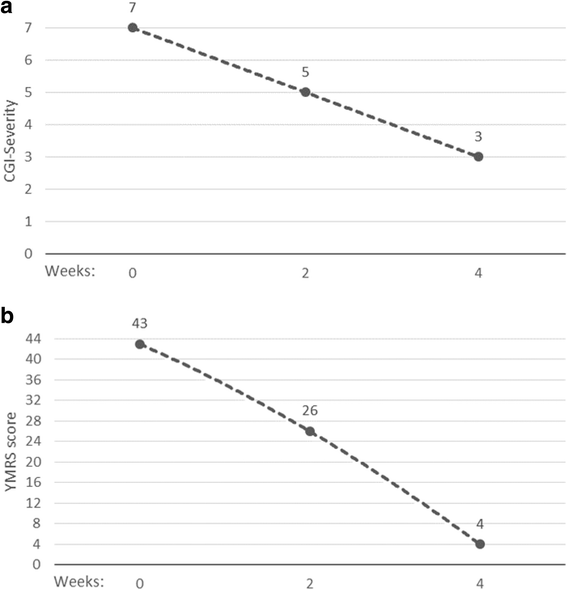Electroconvulsive therapy for manic state with mixed and psychotic features in a teenager with bipolar disorder and comorbid episodic obsessive-compulsive disorder: a case report
- PMID: 29228982
- PMCID: PMC5725801
- DOI: 10.1186/s13256-017-1508-8
Electroconvulsive therapy for manic state with mixed and psychotic features in a teenager with bipolar disorder and comorbid episodic obsessive-compulsive disorder: a case report
Abstract
Background: Comorbidity of bipolar disorder and obsessive-compulsive disorder is common in adolescence. Obsessive-compulsive disorder symptoms may be episodic and secondary to alterations in mood, and display specific features. Management of pediatric bipolar disorder-obsessive-compulsive disorder is challenging, as pharmacotherapy of obsessive-compulsive disorder may induce or exacerbate manic episodes and there is limited evidence of treatment efficacy. Electroconvulsive therapy is sparsely used in children and adolescents, but is documented to be a safe and efficacious intervention in adults with bipolar disorder. In view of the severity of symptoms in juvenile mania, studies on treatment strategies are warranted. We report a case of an adolescent with bipolar disorder-obsessive-compulsive disorder who was successfully treated with electroconvulsive therapy during an episode of severe mania.
Case presentation: A 16-year-old girl of Middle East origin first presented to us with depressed mood, irritability, and increased obsessive-compulsive disorder symptoms, which were initially interpreted in the context of acute stress secondary to migration. She had been diagnosed with bipolar disorder and obsessive-compulsive disorder in her previous home country, but had difficulties in accounting for earlier psychiatric history. During hospitalization her mood switched to a manic state with mixed and psychotic features, at times showing aggression toward others. Interruption in her lithium treatment for a short period and possibly the introduction of an atypical antipsychotic could in part have been triggering factors. After 8 weeks of in-patient care and psychotropic drug trials, electroconvulsive therapy was initiated and administered every second or third day for 4 weeks, with marked positive response. No apparent side effects were reported.
Conclusions: This case demonstrates the need for a detailed medical history, taking special note of periodicity and character of obsessive-compulsive disorder symptoms, in adolescents with mood disorders. When treating culturally diverse patients, extra consideration should be taken. Special concerns in the pharmacological treatment to avoid the patient's condition from worsening must be addressed, including giving priority to mood stabilization before obsessive-compulsive disorder symptoms. There are potential benefits in considering electroconvulsive therapy in young patients with severe mania where first-line treatment options have failed.
Keywords: Adolescents; Bipolar disorder; Comorbidity; Diagnostic and Statistical Manual of Mental Disorders; Electroconvulsive therapy; Obsessive-compulsive disorder.
Conflict of interest statement
Ethics approval and consent to participate
Not applicable
Consent for publication
Written informed consent was obtained from the patient and her legal guardians for publication of this case report. A copy of the written consent is available for review by the Editor-in-Chief of this journal.
Competing interests
The authors declare that they have no competing interests.
Publisher’s Note
Springer Nature remains neutral with regard to jurisdictional claims in published maps and institutional affiliations.
Figures
Similar articles
-
Maintenance therapy with electroconvulsive therapy in a patient with a codiagnosis of bipolar disorder and obsessive-compulsive disorder.J ECT. 2013 Jun;29(2):e21-2. doi: 10.1097/YCT.0b013e31827b4e76. J ECT. 2013. PMID: 23519221
-
Updates in treating comorbid bipolar disorder and obsessive-compulsive disorder: A systematic review.J Affect Disord. 2019 Sep 1;256:433-440. doi: 10.1016/j.jad.2019.06.015. Epub 2019 Jun 6. J Affect Disord. 2019. PMID: 31234022
-
[Alpha-interferon and mental disorders].Encephale. 2001 Jul-Aug;27(4):308-17. Encephale. 2001. PMID: 11686052 Review. French.
-
Clinical expression of obsessive-compulsive disorder in women with bipolar disorder.Braz J Psychiatry. 2005 Jun;27(2):139-42. doi: 10.1590/s1516-44462005000200013. Epub 2005 Jun 13. Braz J Psychiatry. 2005. PMID: 15962140
-
Obsessive-compulsive-bipolar comorbidity: a systematic exploration of clinical features and treatment outcome.J Clin Psychiatry. 2002 Dec;63(12):1129-34. J Clin Psychiatry. 2002. PMID: 12523872
Cited by
-
Electroconvulsive therapy in children and adolescents in Europe-a systematic review of the literature complemented by expert information and guideline recommendations.Eur Child Adolesc Psychiatry. 2024 Oct;33(10):3389-3403. doi: 10.1007/s00787-023-02248-y. Epub 2023 Jul 17. Eur Child Adolesc Psychiatry. 2024. PMID: 37458849
References
-
- Amitai M, Chen A, Weizman A, Apter A. SSRI-induced activation syndrome in children and adolescents—what is next? Curr Treat Options Psych. 2015;2:28–37. doi: 10.1007/s40501-015-0034-9. - DOI
Publication types
MeSH terms
Substances
LinkOut - more resources
Full Text Sources
Other Literature Sources
Medical


